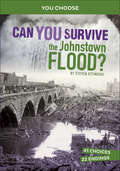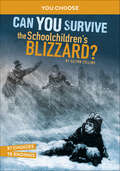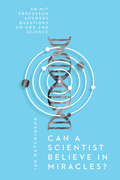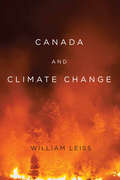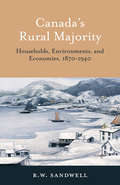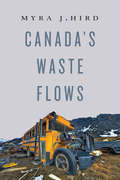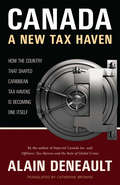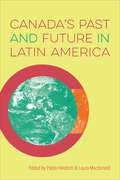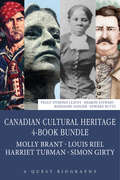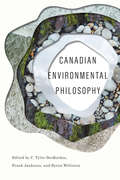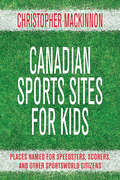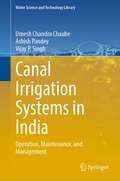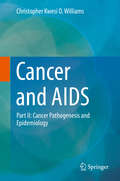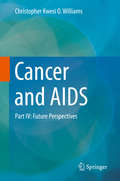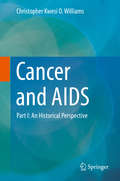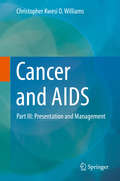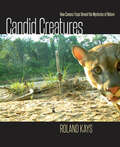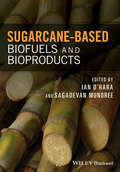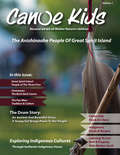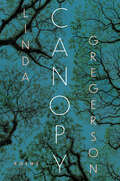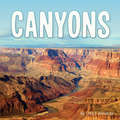- Table View
- List View
Can You Survive the Johnstown Flood?: An Interactive History Adventure (You Choose: Disasters in History)
by Steven OtfinoskiOn May 31, 1889, heavy rains and a dam failure sent flood waters sweeping into Johnstown, Pennsylvania. The 50-foot-high wall of water quickly demolished much of the town. Will you and your new husband be able to escape certain doom as you wait for your train to leave the station? Can you climb onto your house’s roof for safety before the building completely fills with water? Will you join in the effort to save others who are floating by on the roofs of their houses? With dozens of possible choices, it’s up to YOU to find a way to survive one of the deadliest disasters in American history.
Can You Survive the Schoolchildren's Blizzard? (You Choose)
by Ailynn CollinsIt is January 12, 1888, and you are caught by surprise by a powerful blizzard that sweeps across the Midwest. Dangerously cold temperatures, high winds, and deep snow make travel nearly impossible. Will you be able to find your way home through the storm after leaving school? Can you find your father after he becomes lost in the blinding snow? Will you be able to help your students find shelter after the storm ruins your schoolhouse? With dozens of possible choices, it’s up to YOU to find a way to survive one of history’s worst blizzards.
Can You Survive the Schoolchildren's Blizzard?: An Interactive History Adventure (You Choose: Disasters in History)
by Ailynn CollinsIt is January 12, 1888, and you are caught by surprise by a powerful blizzard that sweeps across the Midwest. Dangerously cold temperatures, high winds, and deep snow make travel nearly impossible. Will you be able to find your way home through the storm after leaving school? Can you find your father after he becomes lost in the blinding snow? Will you be able to help your students find shelter after the storm ruins your schoolhouse? With dozens of possible choices, it’s up to YOU to find a way to survive one of history’s worst blizzards.
Can a Scientist Believe in Miracles?: An MIT Professor Answers Questions on God and Science (Veritas Books)
by Ian HutchinsonWhat is faith and what is science? Are they compatible? Are there realities science cannot explain? Is God's existence a scientific question? Is the Bible consistent with the modern scientific understanding of the universe? Are there scientific reasons to believe in God?
Canada and Climate Change (Canadian Essentials)
by William LeissPandemics, massive earthquakes, war, and other catastrophes inspire immediate action because their casualties and destruction are immediately visible. Climate change is an unyielding problem because its long-range dangers are hidden, and thus it is a global risk unlike anything in human experience.The federal government recently announced aggressive climate targets for Canada. We have committed to producing net-zero greenhouse gas emissions by 2050, which will require major changes for our economy and way of life. Canadian citizens need to understand why our most distinguished climate scientists and our senior political leaders think that we must meet this target. Canada and Climate Change explains the importance of policies that will ensure we meet the net-zero emissions target. William Leiss provides a firm grasp on what climate change is and how scientists have described shifts in the earth’s climate as they have occurred over hundreds of millions of years and as they are likely to occur in the near future, especially by the end of this century.Leiss argues that citizens have a right to place their trust in what climate scientists tell us. Canada and Climate Change is an essential primer on where we stand on the issue of climate change in Canada and what will unfold in the years ahead.
Canada's Rural Majority: Households, Environments, and Economies, 1870-1940
by R. W. SandwellBefore the Second World War, Canada was a rural country. Unlike most industrializing countries, Canada's rural population grew throughout the century after 1871 - even if it declined as a proportion of the total population. Rural Canadians also differed in their lives from rural populations elsewhere. In a country dominated by a harsh northern climate, a short growing season, isolated households and communities, and poor land, they typically relied on three ever-shifting pillars of support: the sale of cash crops, subsistence from the local environment, and wage work off the farm.Canada's Rural Majority is an engaging and accessible history of this distinctive experience, including not only Canada's farmers, but also the hunters, gardeners, fishers, miners, loggers, and cannery workers who lived and worked in rural Canada. Focusing on the household, the environment, and the community, Canada's Rural Majority is a compelling classroom resource and an invaluable overview of this understudied aspect of Canadian history.
Canada's Waste Flows
by Myra J. HirdFrom shipments of Canadian waste rotting in developing countries to overflowing landfills and ineffective recycling programs, Canada is facing a waste crisis. Canadians are becoming increasingly aware that waste is an acute environmental and human health issue – and a complex one, the solutions to which are often contradictory.Canada's Waste Flows is an honest look at the production and movement of Canadian waste, from region to region and across the globe, and its consequences. Through a series of timely empirical case studies, the book reveals waste as less of a technological problem and more of a material, economic, political, historical, and cultural concern. Canada's Waste Flows demonstrates that Canadians are misdirecting their attention to post-consumer waste and their responsibility for minimizing it through recycling; waste must be understood as a social justice issue, and in particular as a symptom of ongoing settler colonialism. Through a comparative study of waste management in southern and northern Canadian communities, Myra Hird argues that we will only resolve our waste crisis through democratic engagement.A critical and compelling book that will generate conversation and incite change, Canada's Waste Flows uncovers how Canada's role as a global leader in waste production and export is key to changing Canada's waste future.
Canada: A New Tax Haven
by Alain Deneault Catherine BrowneIn Canada: A New Tax Haven, Alain Deneault traces Canada's relationship with Commonwealth Caribbean nations back through the last half of the twentieth century, arguing that the involvement of Canadian financiers in establishing and maintaining Caribbean tax havens has predisposed Canada to become a tax haven itself - a metamorphosis well under way.Canada was linked to Caribbean nations long before they became tax havens. In the 1950s, an ex-governor of Canada's central bank attempted to establish a low taxation regime in Jamaica. In the 1960s, the transformation of the Bahamas into a tax haven characterized by impenetrable banking secrecy was shaped by a minister of finance who sat on the Royal Bank of Canada's board of directors. A Calgary lawyer and former Conservative Party heavyweight drew up the clauses that transformed the Cayman Islands into an opaque offshore jurisdiction. For years, Canadian politicians have debated annexing tax havens such as the Turks and Caicos Islands, making them part of Canadian territory. Canada has signed a free-trade agreement with Panama and is currently seeking a wider agreement with countries in CARICOM, the Caribbean economic community. And, notably, Canada currently shares its seat at the World Bank and the International Monetary Fund with a group of Caribbean tax havens.These exercises in fostering fiscal and banking leniency have predisposed Canada to become one of the most attractive tax havens to foreign interests. Not only does Canada offer one of the lowest corporate tax rates in the world, but a number of loopholes encourage companies to relocate to Canada as if it were Barbados or Bermuda.Canada: A New Tax Haven is an attempt to analyze the situation and address its implications for Canadians.
Canada’s Past and Future in Latin America
by Laura Macdonald Pablo HeidrichMany historians and political scientists argue that ties between Canada and Latin America have been weak and intermittent because of lack of mutual interest and common objectives. Has this record of diverging paths changed as Canada has attempted to expand its economic and diplomatic ties with the region? Has Canada become an imperialist power? Canada’s Past and Future in Latin America investigates the historical origins of and more recent developments in Canadian foreign policy in the region. It offers a detailed evaluation of the Harper and Trudeau governments’ approaches to Latin America, touching on political diplomacy, bilateral development cooperation, and civil society initiatives. Leading scholars of Canada–Latin America relations offer insights from unique perspectives on a range of issues, such as the impact of Canadian mining investment, security relations, democracy promotion, and the changing nature of Latin American migration to Canada. Drawing on archival research, field interviews, and primary sources, Canada’s Past and Future in Latin America advances our understanding of Canadian engagement with the region and evaluates options for building stronger ties in the future.
Canadian Cultural Heritage 4-Book Bundle: Molly Brant / Louis Riel / Harriet Tubman / Simon Girty
by Edward Butts Sharon Stewart Peggy Dymond Leavey Rosemary SadlierPresenting four titles in the Quest Biography series profiling prominent figures in Canada’s history. In these four books, we explore the cultural heritage at the roots of Canada’s present-day multicultural society. In the lives of abolitionist Underground Railway hero Harriet Tubman, Metis revolutionary Louis Riel, frontiersman Simon Girty, and aboriginal elder stateswoman Molly Brant, we discover that the struggle for inclusion and human rights has existed since the dawn of Canada’s modern history. Includes: Harriet Tubman Louis Riel Simon GirtyMolly Brant
Canadian Environmental Philosophy
by Byron Williston C. Tyler DesRoches Frank JankunisCanadian Environmental Philosophy is the first collection of essays to take up theoretical and practical issues in environmental philosophy today, from a Canadian perspective. The essays cover various subjects, including ecological nationalism, the legacy of Grey Owl, the meaning of “outside” to Canadians, the paradigm shift from mechanism to ecology in our understanding of nature, the meaning and significance of the Anthropocene, the challenges of biodiversity protection in Canada, the conservation status of crossbred species in the age of climate change, and the moral status of ecosystems. This wide range of topics is as diverse and challenging as the Canadian landscape itself. Given the extent of humanity's current impact on the biosphere – especially evident with anthropogenic climate change and the ongoing mass extinction – it has never been more urgent for us to confront these environmental challenges as Canadian citizens and citizens of the world. Canadian Environmental Philosophy galvanizes this conversation from the perspective of this place.
Canadian Environmental Philosophy
by C. Tyler DesRoches, Frank Jankunis, and Byron WillistonCanadian Environmental Philosophy is the first collection of essays to take up theoretical and practical issues in environmental philosophy today, from a Canadian perspective. The essays cover various subjects, including ecological nationalism, the legacy of Grey Owl, the meaning of “outside” to Canadians, the paradigm shift from mechanism to ecology in our understanding of nature, the meaning and significance of the Anthropocene, the challenges of biodiversity protection in Canada, the conservation status of crossbred species in the age of climate change, and the moral status of ecosystems. This wide range of topics is as diverse and challenging as the Canadian landscape itself. Given the extent of humanity's current impact on the biosphere – especially evident with anthropogenic climate change and the ongoing mass extinction – it has never been more urgent for us to confront these environmental challenges as Canadian citizens and citizens of the world. Canadian Environmental Philosophy galvanizes this conversation from the perspective of this place.
Canadian Sports Sites for Kids: Places Named for Speedsters, Scorers, and Other Sportsworld Citizens
by Christopher MackinnonEverything you need to know about Canadian places named after our sports stars. In Canada, sports aren’t just entertainment; they’re literally part of the landscape. We’ve named everything from parks and streets to schools and stadiums after some of our favourite pro athletes and sports figures past and present. Wayne Gretzky Drive, Mike Weir Park, Roberto Luongo Arena, the Cindy Klassen Centre, Justin Morneau Field — Canadian Sports Sites for Kids is your entertaining, map-filled guidebook to hundreds of these special locations. The fast-paced stories, maps, and lists highlight everything you need to know about Canada’s sports geography.Plus, explore other little-known sites of interest, such as: • The Canadian city that named a park after an arm-wrestling promoter • The Ontario town that honoured a hockey fan with a place name • The Prince Edward Island village where the biggest street is named for the writer of "The Hockey Song" • The whereabouts of Canada’s only street named for a boxing champ
Canadians and the Natural Environment to the Twenty-First Century
by Neil S ForkeyCanadians and the Natural Environment to the Twenty-First Century provides an ideal foundation for undergraduates and general readers on the history of Canada's complex environmental issues. Through clear, easy-to-understand case studies, Neil Forkey integrates the ongoing interplay of humans and the natural world into national, continental, and global contexts.Forkey's engaging survey addresses significant episodes from across the country over the past four hundred years: the classification of Canada's environments by its earliest inhabitants, the relationship between science and sentiment in the Victorian era, the shift towards conservation and preservation of resources in the early twentieth century, and the rise of environmentalism and issues involving First Nations at the end of the century. Canadians and the Natural Environment to the Twenty-First Century provides an accessible synthesis of the most important recent work in the field, making it a truly state-of-the-art contribution to Canadian environmental history.
Canal Irrigation Systems in India: Operation, Maintenance, and Management (Water Science and Technology Library #126)
by Vijay P. Singh Ashish Pandey Umesh Chandra ChaubeThe book focuses broadly on the preliminaries of the canal irrigation systems in India with a focus on their operation, maintenance, and management of the canal systems. The chapters in this book are classified under four sections, viz., (i). preliminaries of the canal irrigation systems, (ii) operation of the canal irrigation systems, (iii) maintenance of the canal irrigation systems, and (iv) management of the canal irrigation systems. The preliminaries of the canal irrigation systems include an integrated view of irrigation and agriculture, irrigation management in India: problems, issues, a brief history, and some lessons, irrigation administration, organizational structure for management of irrigated agriculture, and farmers’ participation. The operation of the canal irrigation systems includes the operation of dams and barrages, canal operation, water distribution planning, measurement of flow and sediment in canals, and performance evaluation of the canal irrigation system, use of groundwater in the canal command area. The canal irrigation systems' maintenance includes dams, barrages, related equipment, canals and related structures, field drainage, diagnostic analysis of canal irrigation system, soil and water quality management, soil moisture, and measurement. The management of the canal irrigation systems includes rehabilitation and modernization and a case study on rehabilitation, conjunctive use management, operation, and maintenance budgeting, and financing. The book is expected to be useful for academicians, water practitioners, scientists, water managers, environmentalists, administrators, NGOs, researchers, and students who are actively involved in the operation, maintenance, and management of the canal irrigation system for addressing the challenges being faced in the irrigated agricultural while addressing issues of canal irrigation systems in South East Asia.
Cancer and AIDS: Part Iv: Future Perspectives
by Christopher Kwesi WilliamsThe lifestyles and socio-economic status that are prevalent in regions of the world with limited resources form the background for the unique features of neoplastic diseases in these areas, where the majority of the world population lives. The predominance of the world’s retroviral burden of in these areas further compounds the nature and challenges of the cancer there. Much of the international cancer literature covers the nature and challenges of the disease as seen in high-income regions of the world, thereby giving a skewed view of the global cancer challenges. As the low- and middle-income regions of the world transition from communicable to non communicable disease patterns, there is a need for a corresponding paradigm shift, with increased emphasis on what the world needs to know about non communicable diseases, including cancer, where the disease is hitherto poorly documented. The main goal of the proposed book is to contribute to this outcomes.
Cancer and AIDS: Part Iv: Future Perspectives
by Christopher Kwesi WilliamsThe lifestyles and socio-economic status that are prevalent in regions of the world with limited resources form the background for the unique features of neoplastic diseases in these areas, where the majority of the world population lives. The predominance of the world’s retroviral burden of in these areas further compounds the nature and challenges of the cancer there. Much of the international cancer literature covers the nature and challenges of the disease as seen in high-income regions of the world, thereby giving a skewed view of the global cancer challenges. As the low- and middle-income regions of the world transition from communicable to non communicable disease patterns, there is a need for a corresponding paradigm shift, with increased emphasis on what the world needs to know about non communicable diseases, including cancer, where the disease is hitherto poorly documented. The main goal of the proposed book is to contribute to this outcomes.
Cancer and AIDS: Part Iv: Future Perspectives
by Christopher Kwesi WilliamsThe lifestyles and socio-economic status that are prevalent in regions of the world with limited resources form the background for the unique features of neoplastic diseases in these areas, where the majority of the world population lives. The predominance of the world’s retroviral burden of in these areas further compounds the nature and challenges of the cancer there. Much of the international cancer literature covers the nature and challenges of the disease as seen in high-income regions of the world, thereby giving a skewed view of the global cancer challenges. As the low- and middle-income regions of the world transition from communicable to non communicable disease patterns, there is a need for a corresponding paradigm shift, with increased emphasis on what the world needs to know about non communicable diseases, including cancer, where the disease is hitherto poorly documented. The main goal of the proposed book is to contribute to this outcomes.
Cancer and AIDS: Part Iv: Future Perspectives
by Christopher Kwesi WilliamsThe lifestyles and socio-economic status that are prevalent in regions of the world with limited resources form the background for the unique features of neoplastic diseases in these areas, where the majority of the world population lives. The predominance of the world’s retroviral burden of in these areas further compounds the nature and challenges of the cancer there. Much of the international cancer literature covers the nature and challenges of the disease as seen in high-income regions of the world, thereby giving a skewed view of the global cancer challenges. As the low- and middle-income regions of the world transition from communicable to non communicable disease patterns, there is a need for a corresponding paradigm shift, with increased emphasis on what the world needs to know about non communicable diseases, including cancer, where the disease is hitherto poorly documented. The main goal of the proposed book is to contribute to this outcomes.
Candid Creatures: How Camera Traps Reveal the Mysteries of Nature
by Roland KaysA riveting collection of photographs capturing wild animals in their native habitats and demonstrating the importance of camera traps.In Candid Creatures, the first major book to reveal the secret lives of animals through motion-sensitive game cameras, biologist Roland Kays has assembled over 600remarkable photographs. Drawing from archives of millions of color and night-vision photographs collected by hundreds of researchers, Kays has selected images that show the unique perspectives of wildlife from throughout the world. Using these photos, he tells the stories of scientific discoveries that camera traps have enabled, such as living proof of species thought to have been extinct and details of predator-prey interactions.Each image captures a moment frozen in the camera’s flash as animals move through their wild habitats. Kays also discusses how scientists use camera traps to address conservation issues, creating solutions that allow humans and wild animals to coexist. More than just a collection of amazing animal pictures, the book’s text, maps, and illustrations work together to describe the latest findings in the fast-moving field of wildlife research.Candid Creatures is a testament to how the explosion of game cameras around the world has revolutionized the study of animal ecology. The powerful combination of pictures and stories of discovery will fascinate anyone interested in science, nature, wildlife biology, or photography.“Full of fabulous pictures of weird and wonderful creatures . . . [Candid Creatures is] loaded with information and carries a strong conservation message.” —Conservation Biology
Cane-based Biofuels And Bioproducts
by Sagadevan MundreeSugarcane has garnered much interest for its potential as a viable renewable energy crop. While the use of sugar juice for ethanol production has been in practice for years, a new focus on using the fibrous co-product known as bagasse for producing renewable fuels and bio-based chemicals is growing in interest. The success of these efforts, and the development of new varieties of energy canes, could greatly increase the use of sugarcane and sugarcane biomass for fuels while enhancing industry sustainability and competitiveness. Sugarcane-Based Biofuels and Bioproducts examines the development of a suite of established and developing biofuels and other renewable products derived from sugarcane and sugarcane-based co-products, such as bagasse. Chapters provide broad-ranging coverage of sugarcane biology, biotechnological advances, and breakthroughs in production and processing techniques. This text brings together essential information regarding the development and utilization of new fuels and bioproducts derived from sugarcane. Authored by experts in the field, Sugarcane-Based Biofuels and Bioproducts is an invaluable resource for researchers studying biofuels, sugarcane, and plant biotechnology as well as sugar and biofuels industry personnel.
Canoe Kids Volume 1: The Anishinnabe (Ojibwe) Peoples of Great Spirit Island
by The communities of Manitoulin Island Canoe KidsCanoe Kids is a book that we hope you will keep. The information, stories and pictures are timeless and will never feel old. The stories are already thousands of years old and they are as relevant now (perhaps more so) than ever before. As your collection grows each new and old edition can be enjoyed, re-read and shared by new and old family members and acquaintances. Our team doesn't just travel and spend a few days in each location. We spend months on location and build real relationships. That means that the materials you read are not only the result of exhaustive work but also of the care and closeness of the friendships made within the community by the Canoe Kids staff. This, we believe, is much more than just reporting. This is our mission and lives too, and we are thrilled to have you join us on our journeys.
Canopy Cities: Protecting and Expanding Urban Forests
by Timothy BeatleyThis book provides a comprehensive overview of the essential role of trees and forests in cities and examines the creative approaches cities around the world are taking to protect trees and expand their urban forests. Moving beyond the view that trees are luxuries and therefore non-essential to the life of a city, the book examines urban tree policies and approaches that foster tree protection, including tree codes and bylaws, and calls for greater community engagement to preserve this important facet of urban life. Through an international range of examples and case studies, featuring cities in the United States, Canada, Singapore, the Netherlands, Australia, France, New Zealand, Mexico, Sierra Leone, and the United Kingdom. The book offers best practice examples where trees have been further integrated into the fabric of urban planning and design, including forested towers, interior rainforests, tiny urban forests, and metropolitan forests. Written by a leading authority in the field, this is a fascinating read for researchers, students, and practitioners in urban planning, landscape architecture, and environmental policy and planning.
Canopy: Poems
by Linda GregersonA long-awaited yet startlingly urgent new collection from &“a contemporary master&”*—a fierce, big-hearted eye on our last, tumultuous decade, and our fragile environment *Los Angeles Review of Books Linda Gregerson&’s long-awaited new collection is a tour de force, a compendium of lives touched by the radical fragility of the planet and, ultimately, the endless astonishment and paradox of being human within the larger ecosystem, &“in a world where every breath I take is luck.&” From the Syrian refugee and ecological crises, to police brutality and COVID, to the Global Seed Vault buried under permafrost, the poems ask: How does consciousness relate to the individual body, the individual to the communal, the community to our environment? How do we mourn a loved one, and how do we mourn strangers? The magnificent poems in Canopy catalogue and reckon with humanity and the natural world, mortality, rage, love, grief, and survival.
Canyons (Earth's Landforms)
by Lisa J. AmstutzAll canyons are deep, steep valleys, but there is more to these landforms than meets the eye! Rivers form some canyons, while the movement of Earth's crust forms others. To get to the bottom of the Grand Canyon in Arizona, you'd have to travel more than a mile! Give beginning readers all the need-to-know information about canyons, including their characteristics, how they form, and where they can be found around the world.
